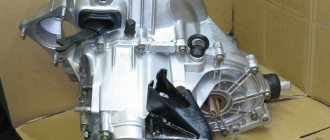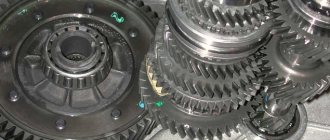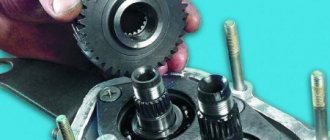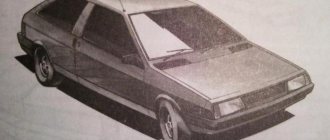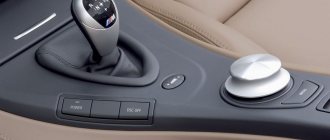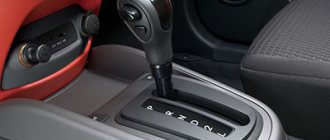Manual transmission - simple design, reliable in operation, economical in maintenance and repair. In addition, the list of advantages of manual transmissions can be supplemented by a relatively low cost compared to analogues, as well as maintainability: almost any problem can be fixed either independently or with the help of specialists, without making a complete replacement.
All of the above advantages begin to fade as soon as an incomprehensible hum, howl, or creaking appears in the gearbox. It’s immediately worth noting that extraneous noise in a manual transmission is a common phenomenon. It affects not only representatives of the domestic automobile industry, but also foreign cars completely assembled abroad.
When assembled well, any manual transmission should operate smoothly without creating noise. If a squeak or hum appears, then you need to look for the cause in a small, or maybe serious, problem with the system. There is no point in postponing diagnostics and repairs, since a manual transmission is one of the main components and assemblies of a modern car.
Get rid of the noise from Suprotek manual transmission
Additive for manual transmission (DSG) "Suprotek manual transmission"
Restores gears and synchronizer couplings in mechanical and robotic transmissions. Eliminates hum and vibration, facilitates gear shifting, and reduces fuel consumption.
more reviews
Feedback about use:
Boris, Pushkino Renault Sandero Stepway
I have been using Suprotec for a long time and am very pleased. Until recently, I treated my first Renault Logan 2013 with Suprotek. Now I continue this on the new Renault Sandero car. The result is obvious, the gearbox works like a clock, the shifts are smooth and the hum has practically disappeared. I recommend to all. I wish good luck to the developers and strengthen control so that there is no counterfeit. That's why I try to buy only from the developer.
The first gear is buzzing - causes, consequences
The gearbox is humming , first gear - congratulations, your case is 80% of manual transmission breakdowns. The first is the most working gear. We start from here; here is the maximum load, since it is necessary to move a car from the zero mark, which when loaded can weigh more than one and a half tons. The load on gears and teeth is enormous. In addition, the winter factor is added, because central Russia means almost five months of negative temperatures, when transmission oil thickens significantly. The transmission hums for two main reasons:
- Insufficient oil level in the gearbox. Accordingly, semi-dry or dry friction;
- The first gear bearing begins to deteriorate.
It is worth noting that in 5% of cases this may be due to a design feature, mainly on Russian cars. The transmission may hum when leaving the conveyor. Moreover, after a run of 15–25,000 km, the bearing will look and feel almost the same as new. But at the same time, the gearbox hums boringly at first speed.
Why does the box howl and make noise?
The main source of noise of varying tones in the VAZ 2109 gearbox is worn out or unadjusted components. Typically, such malfunctions occur on cars with high mileage.
The main reasons why the gearbox on a VAZ 2109 rattles or makes noise are:
- Reduced lubrication level. If the amount of oil is insufficient or its condition is unsatisfactory, the gears and bearings begin to work without a lubricating film, which causes a high-frequency whine of the gearbox. A pair of gears and the fifth gear shaft, located at the maximum height from the lubricant level in the manual transmission housing, are especially susceptible to this phenomenon. When the amount of oil drops significantly, all speeds begin to howl. Sometimes the sound is present only when the box is cold and disappears as it warms up. This is a sign that the liquid is too thick and hardens at low temperatures. Very thin oil, on the other hand, will cause a loud whine as it warms up.
- Worn drive shaft bearings. This is one of the most common causes of rustling noise when the gearbox is operating. The gearbox makes noise when coasting or when the car is stationary and idling.
- Wear of gears in the box. If the gearbox hums in certain gears, then the cause should be sought in wear or chipping of the gear teeth.
- Faulty locking rings. These parts are installed on the lateral conical surfaces of the secondary shaft gears of the box. They have gaps and can rotate freely along with the breadcrumbs. When the ring wears out, cracks and deformations may appear on it, which is why gears begin to shift with a bang.
- Worn synchronizer clutch. If the synchronizer itself fails, a cracking sound appears when gears are engaged and spontaneous speed loss occurs. To eliminate this defect, it is necessary to replace parts.
- Incorrect clutch adjustment. If the setting of the mechanism does not correspond to the norm, then the disks do not turn off completely when the pedal is pressed to the bottom position. In this case, a crunching sound is observed during switching and a characteristic foreign smell is felt due to the burning of the disks.
- Worn release bearing. There is a rustling noise or rumble, but it disappears when the driver depresses the clutch pedal.
Conclusion
As a result, I would like to emphasize the main thing: you should not neglect all kinds of signals that may come from the gearbox, in the form of howling, knocking or special markings on the “tidy”. In the end, repairs can be much more expensive.
In addition, trust the diagnostics, and therefore the disassembly of the box, only to certified or verified services, avoid the so-called “garage” repairmen, from whom you can only get a new “portion” of problems.
VAZ gearbox humming - service or self-treatment?
Why does the VAZ gearbox hum after a mileage of 70–100,000 km? First of all, this is due to the fact that some of the parts have already completely exhausted their service life. For example, the release bearing must be completely replaced. In addition, a hum in a VAZ gearbox may have the following causes:
- The box was operated with gross violations;
- During the next shift, low-quality gear oil or counterfeit oil was poured in, which did not meet the established standards and was not included in the list by the manufacturer;
- During minor repairs of the gearbox, low-quality components were used;
- Technical work or scheduled maintenance was carried out by unqualified personnel or independently, taking into account gross violations.
First of all, high-quality diagnostics will help eliminate all the above reasons and get rid of extraneous gearbox noise. Only she will be able to reveal the truth, find the faulty part, and allow for a truly complete repair.
Breakage of the clutch basket and wear of the pressure plate
To select gears in a manual transmission vehicle, the driver must disengage the engine and transmission using the clutch. When you press the pedal, a special bearing presses on the elastic petals of the clutch basket, resulting in mechanical separation of the engine and transmission. When the clutch disc is closed, torque is constantly transmitted to the input shaft of the gearbox - it spins idle in the gearbox housing. When the petals wear critically, they break off and do not allow the pressure disk to open. The pressure plate clutches also wear out and begin to slip over time, preventing all the torque from being transferred to the wheels of the car. The car stops driving normally, and the engine speed increases when driving at a relatively low speed. Do not forget that clutch parts during normal operation require periodic replacement on average every 100–160 thousand km.
Work transmissions are buzzing - what to do, reasons, analysis of the solution
Other working gears, unlike the first one, must be disassembled in descending order. For example, if the 5th gear is humming, then the problem is the oil level. Fifth gear is physically located above all the others, so if you haven’t added 100-200 ml to the gearbox, then it will be the one that suffers first. Dry or semi-dry gears wear out faster, thereby producing this dull and sometimes squeaking noise.
4th gear is humming - here you need to consider two options. If your car has not even covered 5,000 km yet, then you should just change the oil. Basically, lapping oil, according to many car service experts, does more harm than good. Secondly, the problem may be in the original quality of the factory bearings. Under warranty they should simply be replaced. In 95% of cases, these two actions are enough for the noise in fourth gear to completely disappear.
3rd gear is humming - first check the input shaft bearing. If the machine is under warranty, then it is better to replace this unit. Under no circumstances should you solve the problem yourself unless you are truly an expert in this field.
The second gear is humming - this is most likely a local problem, in the contact patch on the second speed gear on the secondary or input shaft. This statement can be made with a 99% probability if there is no hum, noise or whistle in other gears. The simplest solution is to replace the second gear gears. In addition, it is worth checking the oil level and its quality.
Reverse gear hums - this noise should not be confused with the standard whining or whining when moving in reverse. It's all about the design feature. The gears and teeth of the forward gears are located at an angle, which allows you to move almost silently. The gears and teeth of the reverse gear are located strictly vertically. This is why a peculiar whining or whining sound occurs when reversing. This is a feature of almost any car. Therefore, there is no need to panic and look for the cause of the breakdown in this case.
What to do if the box howls
The first thing a car owner should think about when a howling noise appears in the transmission is a transmission fluid leak. Inspect the car's riser for oil stains, assess the oil level in the box using the dipstick, which most car models have. If the transmission fluid level is below the minimum mark, it must be topped up immediately. Use only the brand of oil that comes in the box. You cannot mix liquids from different manufacturers. You should know that automatic transmissions are very sensitive to the level of lubrication, so an overflow of transmission fluid is as unacceptable as a lack of it. If the oil has not been changed for a long time, it should be done. Automatic transmissions are especially sensitive to the quality of transmission fluid.
If it was not possible to eliminate the howling of the box by replacing or adding oil, you need to go to a service station for diagnostics. Specialists will assess the condition of the transmission and tell you how much repair is needed.
If you decide to sort through the box, you should take into account that the cost of such work is quite high. That is why it is advisable to purchase new original spare parts. Only in this case can you count on a long service life of the transmission after repair. Buying used spare parts or cheap parts from a dubious manufacturer is an imaginary savings. There is a high probability that soon after such repairs the gearbox will have to be disassembled again.
If the main pair is damaged, it is rarely possible to get by only by replacing it. Usually in such a situation other parts also suffer, so you need to evaluate their condition and, if necessary, also replace them.
Sometimes repairing a box turns out to be very difficult and expensive. In this case, it is advisable to replace the entire transmission. You can buy a new unit or find a used box in working condition.
Transmission oil Suprotek Atomium - a universal soldier in manual transmission
As discussed above, half of the problems with gearbox noise and hum are associated with low-quality transmission oil or insufficient filling. For vehicles with a manual transmission, it is recommended to use Suprotek Atomium transmission oil on a fully synthetic basis. This allows you to achieve stable operating properties throughout the entire service life. The peculiarity of this transmission oil is that it practically does not break down when heated, does not oxidize, does not burn at all and does not evaporate. In addition, the mineral impurities included in the composition absolutely do not enter into chemical reactions with wear products, fuel or other additives.
Synthetic gear oil
Synthetic gear oil with viscosity class 75W-90. Buy oil for manual transmission gearbox with a manufacturer's warranty.
more reviews
The use of gear oil 75W-90 SUPROTEC ATOMIUM gives your gearbox the following properties:
- Protection against wear and corrosion;
- Increased resistance to oxidation;
- Stable lubricity even at high temperatures and intensive use;
- Required viscosity at low temperatures, allowing for smooth gear changes;
Synthetic oil is completely safe for oil seals, which also significantly increases their service life.
How to eliminate noise and hum in a gearbox: an alternative to transmission additives
January 25th, 2015 Victor
The “howl” of the gearbox bothers car owners just like any other extraneous sound in the car. The functioning of a serviceable gearbox - mixing of oil, engagement of teeth, operation of bearings - should not be heard while driving. Therefore, the “singing” of the transmission is one of the first reasons to visit the diagnostics.
As a rule, this very “singing” is caused by banal reasons:
- Increasing gaps between individual parts.
- Teeth wear.
- Incorrect oil viscosity.
gearbox additives without any hesitation.
. They pour it in... And they wait for a miracle effect, which you won’t find during the day, even if you look very hard.
The problem is that such drugs are poorly studied. Many of them form a protective film for a limited period of action, so it is not possible to evaluate any long-term positive effect.
The main danger posed by transmission additives
, – corrosive and abrasive wear. This primarily concerns layered, metal-clad additives, and metal conditioners. This feature negates all the advantages of the above-mentioned drugs. Therefore, car owners are looking for a worthy alternative, which is friction geomodifiers. Their main advantages:
1) Possibility of in-place repairs.
2) Formation of a protective layer on the surfaces of mechanisms that is absolutely safe for transmission.
3) Reduced wear rate.
4) Improvement of friction indicators.
The disadvantages of friction geomodifiers include the need to strictly follow the instructions, which is somewhat higher than the cost in the case of additives. Sellers of such products claim 100% effectiveness of the compositions, although they honestly admit: if the wear is more than 60–70%, nothing will help except a complete overhaul with disassembly.
Let's look at what friction geomodifiers are using the example of RVS-Master Tr3, Tr5. Let's figure out why anti-drone additives in gearboxes are significantly inferior to these compounds.
The Finnish-made product received a certificate of compliance with Russian state standards
. The composition is based on magnesium silicates. RBC particles do not change the chemical composition of the oil.
Under the influence of temperature, a new crystal lattice is built on the friction surface: an exchange of Mg and Fe atoms occurs, and a protective metal-ceramic coating is formed. This way the nominal dimensions of the parts are restored. The standard friction system creates an optimal secondary structure that is ideal for the given operating conditions.
Unique features of RVS-Master for gearboxes
1. The effect of using the geomodifier remains even after changing the oil: the new structure continues to work.
2. The components of the product are chemically neutral, therefore they do not react with additives contained in the oil. This proves the complete safety of using the composition.
3. The RVS-Master product restores gear geometry.
4. Wear on the contact patch of the gear is compensated - up to 0.5 mm.
5. The geomodifier reduces the amount of noise and vibration, extends the service life of mechanisms, provides easy and precise switching, and protection against wear in the cold season.
________________________________________________________________________
Published in Featured
Tribotechnical composition of the manual transmission - additional protection with every shift
In addition to high-quality gear oil, problems with manual transmissions can be avoided by using tribological compounds. At their core, they can be classified as additives, but with one very significant amendment. They do not change the physical and chemical properties of the oil, but only complement it. The first thing the tribological compound does is restore the geometry of the gear teeth. A larger amount of oil is retained on the surface of rubbing parts, and clearances are optimized.
recommended products
ExtraSURM ES-1W
Universal anti-friction, water-resistant composite lubricant
215-SURM-Automatic transmission
Preventive additive for automatic transmission
305-SURM-TrV
Transmission rebuilder
306-SURM-CV joint
Bearing and CV joint restorer
Write to us
- Contacts
- Where can I buy
- Articles
- Cooperation
- Online store
- YouTube channel
- TikTok
- Buyer information
- ExtraSURM
- Lubricants
- For engine
- For transmission
- For hydraulic booster
- Ready solutions
- Catalog
- Application experience
- Terms of use
- © PIOTR LLC
- 1991 — 2022
Summing up
When repairing a singing gearbox, it is important to remember the poor quality of manufactured units and spare parts. It is not indicative that the purchased spare parts or units are new - they may also have defects
Sometimes, with minor noise in the gearbox, it is easier to turn up the volume of the radio in the cabin than to try to eliminate the cricket by going through the box several times.
Good luck on the roads!
Many drivers unknowingly confuse the symptoms of a manual transmission malfunction with signs of a breakdown in the gear selection mechanism or clutch. Fortunately, manual transmissions require much less attention than automatic transmissions, CVTs, DSG and robotic gearboxes. But even highly reliable units eventually begin to make noise at idle, while driving, and suffer from poor gear shifting.
Oil stains
Oil leaks on the gearbox housing or under the bottom of the car require an immediate solution to the problem. Oil can ooze through damaged gear selector rod seals, wheel drive boots, or due to mechanical damage to the unit housing. If a manual transmission loses oil, it overheats and quickly fails, and the automatic transmission stops working altogether. It is difficult to confuse torque converter fluid with other oils used in a car - it has a reddish tint, a pungent odor and a sweetish taste. Unlike the engine, the transmission should not lose oil over time - it does not burn out and does not go anywhere if the unit is in good condition. Checking the oil level is sometimes difficult - there is usually no special dipstick for this; control and addition of fluid is carried out through the filler plug on the housing.
Knocking under the hood, whistling.
If you hear a knocking noise under the hood of your car, please be very careful, as the cause of such a knocking noise may be a specific engine malfunction. These sounds can primarily be associated with three main causes of fuel ignition (combustion) malfunction in the engine combustion chamber. The first reason may be related to ignition problems (malfunction of the ignition coil, high-voltage wires). Another (second) cause of this malfunction may be a clogged injector.
Please remember that due to poor ignition, pops or knocks can occur under the hood of the car, which can lead to excessive detonation when burning fuel in the engine itself. And detonation, friends, can damage the engine.
Due to incorrect or faulty ignition, several flame sources can form in the combustion chamber, which, when meeting each other inside the engine, will create excess pressure in the combustion chamber. Detonation is a big problem for an engine. It can significantly damage the engine pistons.
If your car has an ignition problem and this is due to low-quality fuel and possibly for other reasons, then fill the fuel tank with high-octane gasoline and this way you can correct the problem that has arisen in the car.
The bolts securing the gearbox to the engine are poorly secured
The bolts securing the gearbox to the engine housing tend to unscrew spontaneously. This may occur due to vibrations when driving over uneven surfaces or due to unstable operation of the internal combustion engine. As a result, noise appears when the engine is idling.
If these symptoms have appeared recently, the issue can be resolved by simply tightening the bolts using a torque wrench to control the tightening torque. However, ignoring the problem often leads to more serious consequences. This is the destruction of the mounting supports of the unit and the engine, failure of synchronizer couplings, increased wear of the clutch disc, etc.
Features of noise from automatic transmissions, determination of the nature of breakdowns, methods for eliminating them
When stopping a vehicle, you can often hear a sound similar to the piercing wail of a siren. This type of noise occurs when the torque converter is operating. This signal should not cause much concern to the driver if it is short-term in nature. The appearance of an incessant howl, changing the tone depending on the engine speed, indicates the appearance of serious defects in the automatic transmission:
- Worn gears in the oil pump.
- Leaks, burnout of transmission oil.
- Abrasion of gaskets, O-rings, etc.
- Air penetration into the oil pump housing.
- Incorrect arrangement of gears in the oil pump housing (errors in the manufacture and assembly of the unit).
- Loss of gear engagement in the pump.
What causes the buzzing noise? It has been noted that the intensity of noise of this type depends on the rotation speed of the output shaft of the power unit. They arise due to increased vibration and oscillations of the line pressure oil valve (regulator valve). To eliminate unpleasant noise, it is necessary to replace thinned oil seals, cuffs and other sealing elements that have failed.
Continuous rattling appears when the engine is running at low speeds. In this case, you need to check:
- Performance of torque converter elements (donut).
- Integrity of hydraulic pump blades;
- Serviceability of the turbine wheel.
- How damper springs work. Intermittent vibrations and rattling when the vehicle moves also occur due to damage to the engine flywheel to which the torque converter is attached. Vibrating noises often disappear for a short period when the lever is moved to the Park or Neutral position (P, N).
What do metallic clanging noises indicate when idling? Typical causes here are worn clutch friction disc gaskets. To eliminate this defect and replace the clutch packs, you will have to dismantle the automatic transmission using special lifting equipment in a service station.
The hum and rattle in the area where the differential mechanism is located is the result of problems arising in this device:
- wear of the gear teeth of both driven and drive shafts;
- bearings;
- jamming of the working elements of the differential due to increased play of the satellite elements.
What does the noise in the automatic transmission indicate when you engage a gear or change from one mode to the next? The main reason is a malfunction of the operating gear elements in the corresponding rows of the planetary mechanism. When noises change in volume and pitch when the next gear is engaged or the automatic transmission selector is switched to reverse mode, most likely the thrust bearings (liners) have become unusable.
How to minimize the risk of manual transmission breakdown
Basic rules to follow:
- Driving style.
Acceleration in jerks at exorbitant engine speeds leads to the breakdown of not only the manual transmission, but also the vehicle engine. It is necessary to ensure a comfortable and dynamic change and transmission of torque from the motor to the wheels. Gear shifting should be smooth and consistent with speed - this reduces the load and wear on the vehicle engine and gearbox. - Timely maintenance of manual transmission.
The transmission fluid replacement interval is no more than 3 years or every 40 - 50 thousand kilometers (for some brands a longer interval is acceptable). The oil change period is regulated by the manufacturer and is indicated in the Operation Manual for each individual vehicle brand. - Quality of transmission fluids and spare parts.
Since oil changes and manual transmission repairs are infrequent, you should not skimp on purchasing the appropriate fluids and original components approved by the vehicle manufacturer. - Timely maintenance.
It is advisable to check the oil level in a manual transmission every six months or 15 thousand kilometers and, if necessary, top it up to the required level. The frequency may be increased under intensive use, aggressive driving style or severe operating conditions.
Video about mechanical failures:
For those with automatic
If your car has an automatic transmission. It will not hurt you to know the modes in which your machine can operate:
- P – For parking and starting the engine. Switching to this mode is possible only after the machine has completely stopped.
- R – To move backwards. Switching to this mode is also possible only after stopping the car and with the brake pedal pressed.
- N – Neutral. When the engine is completely disconnected from the gearbox.
- D – Moving forward without restrictions on gear shifting (the most commonly used operating mode of the automatic transmission).
- D3(S) – Low gears for climbing and braking engines on descents.
- D2 – Mode for difficult conditions (slippery or mountainous roads). Gears above second are not shifted, that is, only first and second gears are engaged.
- D1(L) - Movement occurs only in 1st gear, used off-road on mud, snow or ice, where you need to drive without changing the throttle, and also to overcome steep climbs.
The automatic transmission also has a button on the mode shift lever with the inscription O/D OFF. When it is turned on, the inclusion is prohibited, increasing the gears of the analogue of the 5th gear of the manual transmission. That is, if your automatic machine has 4 gears for moving forward, then for more dynamic acceleration it will use only three lower gears.
About a faulty automatic transmission, an automatic transmission is much more complex than those encountered with a manual transmission, and the chances of repairing it in your garage are slim. But despite this, you still need to know something about it, if only in order not to harm it through improper use.
Bearings are worn out
When the engine is idling, an extraneous noise may be heard from under the clutch pedal, similar to metallic sliding. This is the first sign of wear on the support bearings. If the clutch pedal is depressed, the bearing stops spinning. Consequently, the noise from it stops. This way you can determine that this is the reason.
The fact is that in new bearings the gaps between the balls and the housing are hundredths of microns. As the bearing wears, these clearances increase. Over time, the part loses some of the lubricant, and what remains mixes with dirt and metal microparticles. All this significantly increases the noise of the support bearings during operation.
Next, you need to remove the problematic parts and assess the degree of their wear. If they are in satisfactory condition, it is enough to add lubricant to them and reassemble the box in the reverse order. This will extend the life of the bearings for some time. But the best solution would be to replace them.
Operating principle
The purpose of the device is to ensure uninterrupted connection and disconnection of the clutch discs when the driver presses the pedal.
The operating principle is as follows:
- Through the action of the pressure plate, the driven shaft is pressed against the clutch flywheel.
- The system generates pressure, which is applied to the pressure shaft; this is ensured through the use of a diaphragm spring. Its inner petals are affected by a bearing device.
- The part moves, resulting in separation of the shafts through the action of the fork.
User Alexey Romanov published a video that will help you understand the principle of operation of the clutch system and release bearing.
Determining the nature of the malfunction by sound
In addition to the skills in qualified repair work, the responsibilities of auto mechanics at service centers also include the ability to diagnose vehicle components. Experienced technicians must accurately determine the area where breakdowns occur in automatic transmissions and the degree of their neglect. From a wide variety of sounds, it is necessary to identify suspicious non-standard noises emanating from a faulty car transmission.
To eliminate noise that is not related to the stable operation of the automatic transmission, the mechanic first checks the following devices:
- serviceability of cooling system elements;
- water pump drive belts;
- steering wheel and column mechanism.
When identifying the causes of unusual noise in an automatic transmission, both during movement and during a stop with the engine running, an experienced technician pays attention to:
- periodicity;
- pitch;
- volume;
- tonality, etc.
The cause of the noise when the automatic transmission is engaged in reverse gear is also checked. The results obtained during the diagnostic process provide the basis for an accurate assessment of the structure and degree of damage to the automatic transmission.
Separation of the noise of a working automatic transmission by type
Depending on the nature of the sound of the automatic transmission, unusual noises are divided into the following categories:
- howling;
- buzzing;
- rattling (constantly or intermittently);
- grinding;
- buzzing;
- metal, mechanical, etc.
